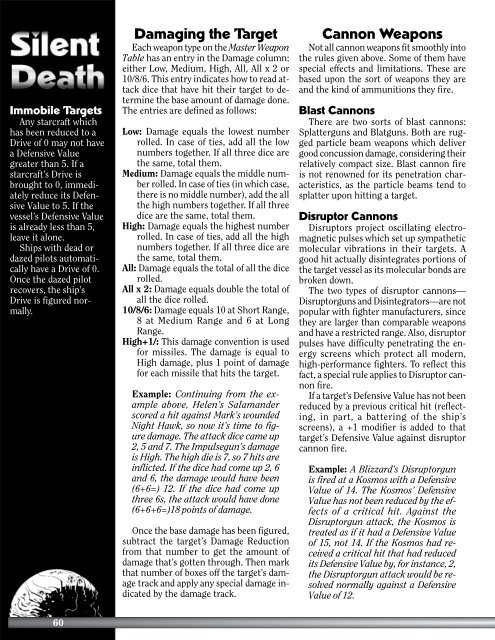Create successful ePaper yourself
Turn your PDF publications into a flip-book with our unique Google optimized e-Paper software.
Immobile Targets<br />
Any starcraft which<br />
has been reduced to a<br />
Drive of 0 may not have<br />
a Defensive Value<br />
greater than 5. If a<br />
starcraft’s Drive is<br />
brought to 0, immediately<br />
reduce its Defensive<br />
Value to 5. If the<br />
vessel’s Defensive Value<br />
is already less than 5,<br />
leave it alone.<br />
Ships with dead or<br />
dazed pilots automatically<br />
have a Drive of 0.<br />
Once the dazed pilot<br />
recovers, the ship’s<br />
Drive is figured normally.<br />
60<br />
Damaging the Target<br />
Each weapon type on the Master Weapon<br />
Table has an entry in the Damage column:<br />
either Low, Medium, High, All, All x 2 or<br />
10/8/6. This entry indicates how to read attack<br />
dice that have hit their target to determine<br />
the base amount of damage done.<br />
The entries are defined as follows:<br />
Low: Damage equals the lowest number<br />
rolled. In case of ties, add all the low<br />
numbers together. If all three dice are<br />
the same, total them.<br />
Medium: Damage equals the middle number<br />
rolled. In case of ties (in which case,<br />
there is no middle number), add the all<br />
the high numbers together. If all three<br />
dice are the same, total them.<br />
High: Damage equals the highest number<br />
rolled. In case of ties, add all the high<br />
numbers together. If all three dice are<br />
the same, total them.<br />
All: Damage equals the total of all the dice<br />
rolled.<br />
All x 2: Damage equals double the total of<br />
all the dice rolled.<br />
10/8/6: Damage equals 10 at Short Range,<br />
8 at Medium Range and 6 at Long<br />
Range.<br />
High+1/: This damage convention is used<br />
for missiles. The damage is equal to<br />
High damage, plus 1 point of damage<br />
for each missile that hits the target.<br />
Example: Continuing from the example<br />
above, Helen’s Salamander<br />
scored a hit against Mark’s wounded<br />
Night Hawk, so now it’s time to figure<br />
damage. The attack dice came up<br />
2, 5 and 7. The Impulsegun’s damage<br />
is High. The high die is 7, so 7 hits are<br />
inflicted. If the dice had come up 2, 6<br />
and 6, the damage would have been<br />
(6+6=) 12. If the dice had come up<br />
three 6s, the attack would have done<br />
(6+6+6=)18 points of damage.<br />
Once the base damage has been figured,<br />
subtract the target’s Damage Reduction<br />
from that number to get the amount of<br />
damage that’s gotten through. Then mark<br />
that number of boxes off the target’s damage<br />
track and apply any special damage indicated<br />
by the damage track.<br />
Cannon Weapons<br />
Not all cannon weapons fit smoothly into<br />
the rules given above. Some of them have<br />
special effects and limitations. These are<br />
based upon the sort of weapons they are<br />
and the kind of ammunitions they fire.<br />
Blast Cannons<br />
There are two sorts of blast cannons:<br />
Splatterguns and Blatguns. Both are rugged<br />
particle beam weapons which deliver<br />
good concussion damage, considering their<br />
relatively compact size. Blast cannon fire<br />
is not renowned for its penetration characteristics,<br />
as the particle beams tend to<br />
splatter upon hitting a target.<br />
Disruptor Cannons<br />
Disruptors project oscillating electromagnetic<br />
pulses which set up sympathetic<br />
molecular vibrations in their targets. A<br />
good hit actually disintegrates portions of<br />
the target vessel as its molecular bonds are<br />
broken down.<br />
The two types of disruptor cannons—<br />
Disruptorguns and Disintegrators—are not<br />
popular with fighter manufacturers, since<br />
they are larger than comparable weapons<br />
and have a restricted range. Also, disruptor<br />
pulses have difficulty penetrating the energy<br />
screens which protect all modern,<br />
high-performance fighters. To reflect this<br />
fact, a special rule applies to Disruptor cannon<br />
fire.<br />
If a target’s Defensive Value has not been<br />
reduced by a previous critical hit (reflecting,<br />
in part, a battering of the ship’s<br />
screens), a +1 modifier is added to that<br />
target’s Defensive Value against disruptor<br />
cannon fire.<br />
Example: A Blizzard’s Disruptorgun<br />
is fired at a Kosmos with a Defensive<br />
Value of 14. The Kosmos’ Defensive<br />
Value has not been reduced by the effects<br />
of a critical hit. Against the<br />
Disruptorgun attack, the Kosmos is<br />
treated as if it had a Defensive Value<br />
of 15, not 14. If the Kosmos had received<br />
a critical hit that had reduced<br />
its Defensive Value by, for instance, 2,<br />
the Disruptorgun attack would be resolved<br />
normally against a Defensive<br />
Value of 12.


